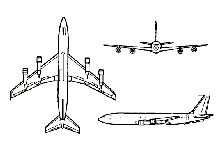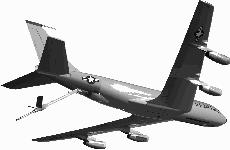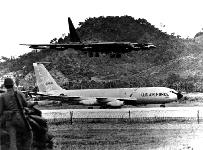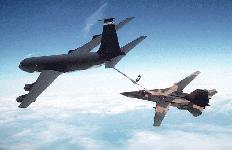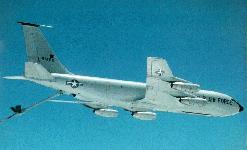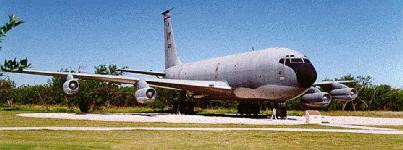





The Boeing Military Airplane Company's model 367-80 was the basic design for the commercial 707 passenger plane as well as the KC-135A Stratotanker. In 1954 the Air Force purchased the first 29 of its future fleet of 732. The first of these aircraft left the assembly line at Boeing Airplane Company, Renton, Washington, July 18, 1956, and flew for the first time August 31, 1956. The Air Force received its first KC-135s at Castle Air Force Base, Calif., Jun 28, 1957. The first aircraft flew in August 1956 and the initial-production Stratotanker was delivered to Castle Air Force Base, Calif., in June 1957. The last KC-135A was delivered to the Air Force in 1965.
About 550 of the tankers built - all by Boeing at its Seattle facilities - remain in service. In addition, Boeing built 88 aircraft in over 30 different models for other Air Force uses, such as flying command posts, pure transports, electronic reconnaissance and photo mapping. The last of these special-purpose aircraft was delivered in late 1966. Responsibility for the KC-135 was transferred to Boeing in Wichita in 1969.
In Southeast Asia, KC-135 Stratotankers made the air war different from all previous aerial conflicts. Mid-air refueling brought far-flung bombing targets within reach. Combat aircraft, no longer limited by fuel supplies, were able to spend more time in target areas.
Structurally, the KC-135 is similar but not identical to the Boeing 707 commercial airliner. It is a swept-wing, long range, high altitude, high speed jet transport. The KC-135 can haul either 83,000 pounds of cargo, airlift up to 80 passengers or carry 202,800 pounds of JP-4 jet fuel, most of which is transferable for global refueling missions.
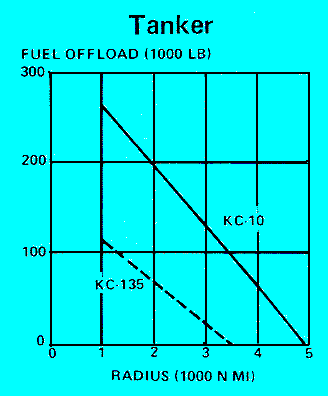 The primary mission of the KC-135 is the refueling of strategic long-range bombers. It also provides air refueling support to Air Force, Navy and Marine Corps aircraft as well as aircraft of allied nations. The KC-135 is equipped with a flying boom for fuel transfer; a special
drogue can be attached to the boom on the ground so it can refuel probe-equipped aircraft. During air refueling, the large flyable boom attached to the airplane's belly can offload fuel at 6,500 pounds per minute. This is enough fuel in one minute to operate an average family car for one year.
The primary mission of the KC-135 is the refueling of strategic long-range bombers. It also provides air refueling support to Air Force, Navy and Marine Corps aircraft as well as aircraft of allied nations. The KC-135 is equipped with a flying boom for fuel transfer; a special
drogue can be attached to the boom on the ground so it can refuel probe-equipped aircraft. During air refueling, the large flyable boom attached to the airplane's belly can offload fuel at 6,500 pounds per minute. This is enough fuel in one minute to operate an average family car for one year.
Normally during inflight refueling the boom operator is in radio contact with the receiver aircraft. The hook-up is made by directions given to the receiver aircraft through a system of lights located on the belly of the aircraft just behind the nose gear. The KC-97 used the same system. The fuel cells in the tanker are made of nylon fabric less than one-sixteenth of an inch thick. A fuel cell weighing 80 pounds will hold seven tons of fuel.
A major program to replace lower wing surfaces on the aircraft was completed in 1988, with a total of 746 C/KC-135 aircraft -- most of them tankers -- modified over a 13-year period. The work involved replacing about 1,500 square feet of aluminum on the underside of the wings -- which carry most of the wing load in flight -- with an improved aluminum alloy. The original wing surface consisted of a type of aluminum more susceptible to fatigue. Skin panels were milled, machined and contoured at Boeing. The wing then went into a rivet assembly jig where stiffeners and skins were joined. The bottom section of the old wing was cut away and replaced by the new sections. In addition to the skin panels, engine strut fittings were also replaced. Each unit required a total of 564 parts, 32,200 steel fasteners and 19,500 aluminum rivets.
Remaining in-service KC-135A's have been modified with new CFM-56 engines produced by CFM-International. The re-engined tanker, designated the KC-135R, can offload 50 percent more fuel, is 25 percent cheaper to operate and is 96 percent quieter than the KC-135A.
Specifications |
|
| Manufacturer: | Boeing Aircraft Company |
| Designation: | KC-135 |
| Version: | A |
| Nickname: | Stratotanker |
| Type: | Tanker |
| Crew: | Four - Pilot Copilot, Navigator and Boom Operator |
| Length: | 136' 3" |
| Height: | 38' 4" |
| Wingspan: | 130' 10" |
| Empty Weight: | 98,466 lbs |
| Max Weight: | 297,000 lbs |
| No. of Engines: | 4 |
| Powerplant: | 4 - Pratt & Whitney J-57-P-59W turbojet |
| Thrust (dry): | 8,000 lbs |
| Thrust (water augmentation): | 11,000 lbs |
| Max Speed: | 530 mph at 30,000 |
| Ceiling: | 50,000 ft |
| Range (with 120,000 lbs of transfer fuel): | 1,150 mi |
| Range (ferry mission): | 9,200 mi |
| Armament | none |
